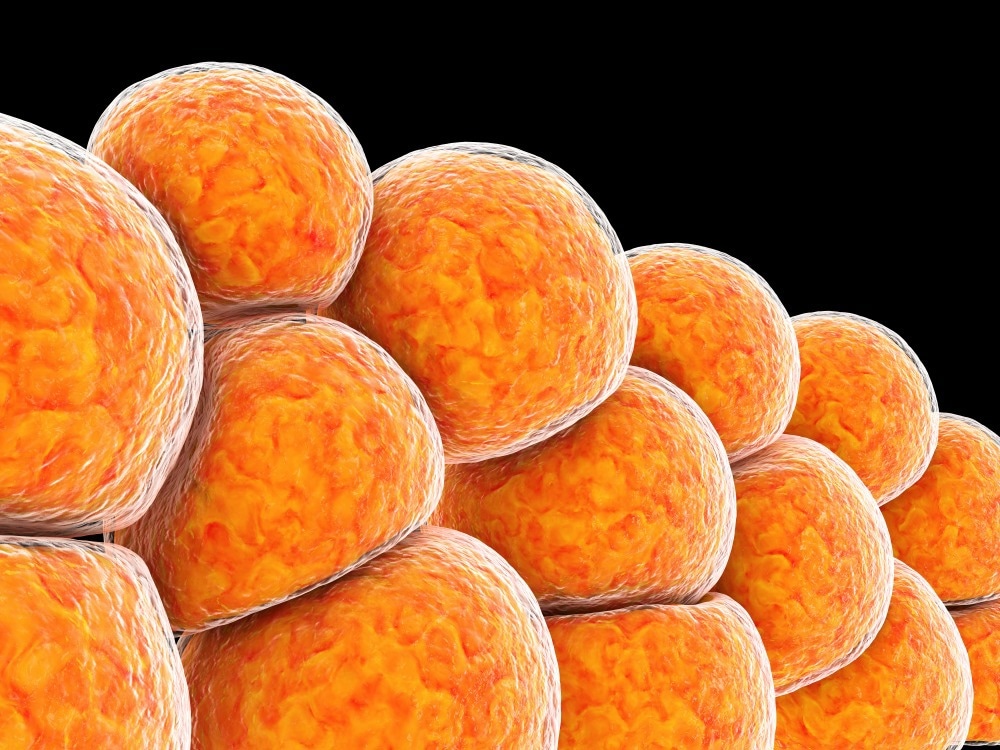In a recent study published in Nature Communications, researchers demonstrated infection of human adipose tissue by severe acute respiratory syndrome coronavirus 2 (SARS-CoV-2).
 Study: SARS-CoV-2 infects adipose tissue in a fat depot- and viral lineage-dependent manner. Image Credit: Victor Josan/Shutterstock
Study: SARS-CoV-2 infects adipose tissue in a fat depot- and viral lineage-dependent manner. Image Credit: Victor Josan/Shutterstock
Background
Obesity increases the risk of severe coronavirus disease 2019 (COVID-19). Cells in the adipose tissue express angiotensin-converting enzyme 2 (ACE2), and the presence of lipid droplets favors viral replication and inflammatory insult. Males have been disproportionately affected by the COVID-19 pandemic, with a higher incidence of severe illness in the male population than in females.
Moreover, fat distribution is different between sexes – females have higher subcutaneous fat mass, whereas males have more visceral fat. Therefore, deciphering how fat depots contribute to SARS-CoV-2 infection is essential to understand the contribution of adipose tissue to COVID-19 pathophysiology.
The study and findings
In the present study, researchers evaluated adipose tissues for evidence of SARS-CoV-2 infection. They analyzed autopsied adipose tissue specimens from COVID-19 patients. SARS-CoV-2 RNA was found in 49% (23 out of 47) of tested samples, suggesting that fat serves as an extrapulmonary site for SARS-CoV-2 RNA in deceased COVID-19 patients.
The spike protein of SARS-CoV-2 was detected in the adipose tissue of those with the viral genome in fat. Adipocytes were also among the cells infected with SARS-CoV-2. Viral load in the adipose tissue was highly variable across individuals. No statistical associations of viral load in the adipose tissue were found with age, sex, body weight, and body mass index (BMI).
Next, the researchers assessed the ability of SARS-CoV-2 to replicate in adipose cells from different anatomical sites. Fat depot differences were compared in vitro using primary stromal-vascular cells from visceral or subcutaneous adipose tissues from patients undergoing abdominal surgery. These cells were differentiated into adipocytes using an optimized protocol. No differences were evident between visceral (Vis AD) and subcutaneous (Sub AD) adipose tissue-derived cells.
The viral load increased over time after infection of these differentiated cells with the ancestral B lineage of SARS-CoV-2. The ability of SARS-CoV-2 (B lineage) to replicate in Vis AD and Sub AD cells was confirmed by immunofluorescence. Notably, the viral load in Vis AD cells was 240-fold higher than in Sub AD cells 24 hours post-infection (hpi).
The authors observed > 770-fold more infectious viral particles in Vis AD cells than in Sub AD cells at 24 hpi in plaque-forming assays. Both Vis AD and Sub AD cells expressed ACE2. Still, Vis AD cells had higher ACE2 mRNA and protein levels than Sub AD cells, implying that the difference in the susceptibility of these cells to SARS-CoV-2 is partly determined by ACE2 abundance.
Next, they investigated if these cells were similarly susceptible to a SARS-CoV-2 Gamma (P.1), a variant of concern (VOC). The viral load (of P.1) in Vis AD cells at 24 hpi was 17 times lower than in cells infected with SARS-CoV-2 (B) but 35-fold higher than in Sub AD cells. The Sub AD cells showed no differences between SARS-CoV-2 (B) and SARS-CoV-2 (P.1) viral loads.
The infection of Vis AD and Sub AD cells with SARS-CoV-2 (B) caused pronounced changes in the proteomic profiles at 24 hpi. Most differentially expressed proteins were downregulated. More than 900 (out of 1415) proteins in Vis AD cells and 774 (out of 1719) in Sub AD cells were significantly altered by SARS-CoV-2 (B).
Besides, P.1 variant infection similarly led to protein downregulation in Sub AD cells. Of the 1446 (differentially expressed) proteins in Vis AD cells, 836 were significantly altered by the P.1 variant. Likewise, 712 (out of 1521) proteins in Sub AD cells were significantly altered by SARS-CoV-2 (P.1). When evaluating the proteome of Vis AD cells for proteins involved in the interferon (IFN) signaling pathway, seven proteins were found altered by SARS-CoV-2 (P.1); five of these were upregulated.
In contrast, six proteins were altered by SARS-CoV-2 (B) in Vis AD cells; five were downregulated. These findings implied differential antiviral responses in the visceral adipose tissue against different SARS-CoV-2 lineages. Furthermore, the authors found increased baseline levels of IFN-Alpha (IFNA) and interleukin-6 (IL6) genes in Vis AD cells than in Sub AD cells. However, IL1B levels were lower in Vis AD cells. Overall, an attenuated cytokine response was observed in cells after exposure to SARS-CoV-2 (P.1).
Conclusions
In summary, the research team has demonstrated that SARS-CoV-2 infects human adipose tissue. Notably, although significant cell death occurs in infected cells, irrespective of viral lineage and cell origin, visceral fat cells appear intrinsically more vulnerable to infection. Despite a marked pro-inflammatory response, the downregulation of proteins involved in IFN signaling was observed in visceral fat cells infected with SARS-CoV-2 (B).
In contrast, proteins involved in IFN signaling are upregulated in SARS-CoV-2 (P.1) infection, with a mild induction of pro-inflammatory markers. Overall, the results suggest adipose tissue infection is a clinically relevant feature of COVID-19 and should be considered when assessing the impact of VOCs on pathogenesis.